The Intel SSD DC S3700 uses a 6Gb/s SATA interface paired with MLC NAND, in-house controller and is offered in both 2.5″ and 1.8″ form factors. The S3700 is designed for the mainstream and high-performance enterprise market segments and carries an aggressive pricing scheme (40% lower MSRP than prior model), making the drive consumable by just about any server compute or flash array need. The easy to deploy message, along with Intel’s heritage of offering SSDs with leading endurance and performance makes the S3700 compelling to a wide range of use cases.
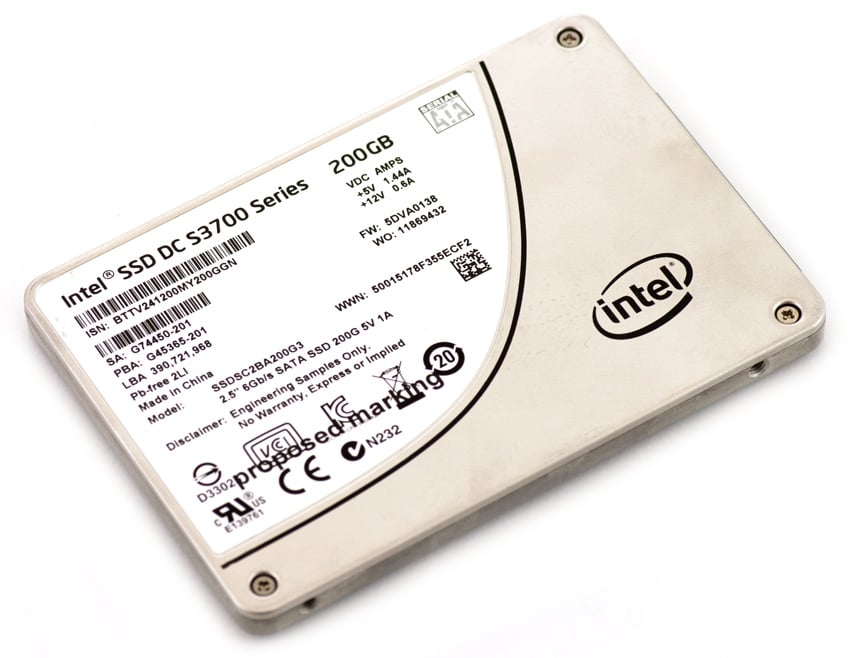
It’s not just performance/endurance this time around that Intel is touting though. While the drive offers 4KB random read IOPS of 75,000 and 36,000 IOPS random write, Intel is claiming a 10% IOPS distribution which offers a tight window of consistent performance. The DC S3700 also drives predictable response times with latencies of <500μs for 99.9% of the time.
When it comes to endurance, like others using MLC NAND, Intel uses their own proprietary approach to drive more write cycles out of the NAND. Of course it helps to own your own controller, NAND and software packages. Intel combines their deep NAND understanding and NAND management for what they call High Endurance Technology (HET). HET lets the DC S3700 handle 10 Drive Writes per Day (DWPD) over a typical 5 year drive life.
The DC S3700 comes in two form factors, the standard 2.5″ in 100GB, 200GB, 400GB, and 800GB capacities and a 1.8″ form factor geared more toward embedded applications in 200GB and 400GB capacity points. Each drive supports full data path protection, AES 256-bit encryption and power loss protection via capacitor. The drive also performs self-checks on boot to ensure proper operation.
As a bit of a housekeeping note, it’s worth noting the DC S3700 starts a new naming convention for Intel, which probably makes sense as their current line of drives (ie 320, 330, 520, 710, 910) doesn’t offer a very clear delineation of which is which. Consumer SSDs are jumbled with enterprise drives and SATA and PCIe interfaces are mixed together in what amounts to a confusing list of three-digit drive names. Intel is moving to a three-tiered consolidation, with the groups being designated Data Center (DC), Professional (client) and Consumer.
Intel SSD DC S3700 Series Specifications
- Capacities
- 2.5”
- 100GB
- Sequential Read: up to 500 MB/s
- Sequential Write: up to 200 MB/s
- Random 4K Read/Write: up to 75,000 IOPS / 19,000 IOPS
- Random 8K Read/Write: 47,500 IOPS / 9,500 IOPS
- 200GB
- Sequential Read: up to 500 MB/s
- Sequential Write: up to 365 MB/s
- Random 4K Read/Write: up to 75,000 IOPS / 32,000 IOPS
- Random 8K Read/Write: 47,500 IOPS / 16,500 IOPS
- 400GB
- Sequential Read: up to 500 MB/s
- Sequential Write: up to 460 MB/s
- Random 4K Read/Write: up to 75,000 IOPS / 36,000 IOPS
- Random 8K Read/Write: 47,500 IOPS / 19,500 IOPS
- 800GB
- Sequential Read: up to 500 MB/s
- Sequential Write: up to 46- MB/s
- Random 4K Read/Write: up to 75,000 IOPS / 36,000 IOPS
- Random 8K Read/Write: 47,500 IOPS / 20,000 IOPS
- 100GB
- 1.8”
- 200GB
- Sequential Read: up to 500 MB/s
- Sequential Write: up to 365 MB/s
- Random 4K Read/Write: up to 75,000 IOPS / 32,000 IOPS
- Random 8K Read/Write: 47,500 IOPS / 16,500 IOPS
- 400GB
- Sequential Read: up to 500 MB/s
- Sequential Write: up to 460 MB/s
- Random 4K Read/Write: up to 75,000 IOPS / 36,000 IOPS
- Random 8K Read/Write: 47,500 IOPS / 19,500 IOPS
- 200GB
- Intel 25nm eMLC NAND
- Read / Write Latency: 45 μs / 65 μs
- Interface SATA 6Gb/s, compatible with SATA 3Gb/s and 1.5Gb/s
- Height: 2.5” 100GB, 200GB, 400GB, and 800GB 7.0 mm thick; 1.8” 5 mm thick
- Weight: 2.5” 200,400,800 GB: 73.6 grams ± 2 grams; 2.5” 100GB: 70 grams ± 2 grams; 1.8” 200, 400GB: 49 grams ± 2 grams
- Life Expectancy: 2 million hours Mean Time Between Failures (MTBF)
- Lifetime Endurance: Up to 10 Drive Writes Per Day
- Power Consumption
- Active: up to 6 W Typical
- Idle: 650 mW Typical
- Operating Temperature: 0° C to 70° C
- 2.5”
Build and Design
The Intel SSD DC S3700 follows the path of the prior SSD 710 Series with a slim 7mm z-height and a 2.5″ form-factor. This slimmer design allows it to fit in more places, such as dense flash arrays, blade servers or embedded applications where space is a premium. These days most SSDs 9.5mm or larger have a lot of free space internally, and only stick with the larger z-height to slot into places designed for traditional 15mm enterprise hard drives.
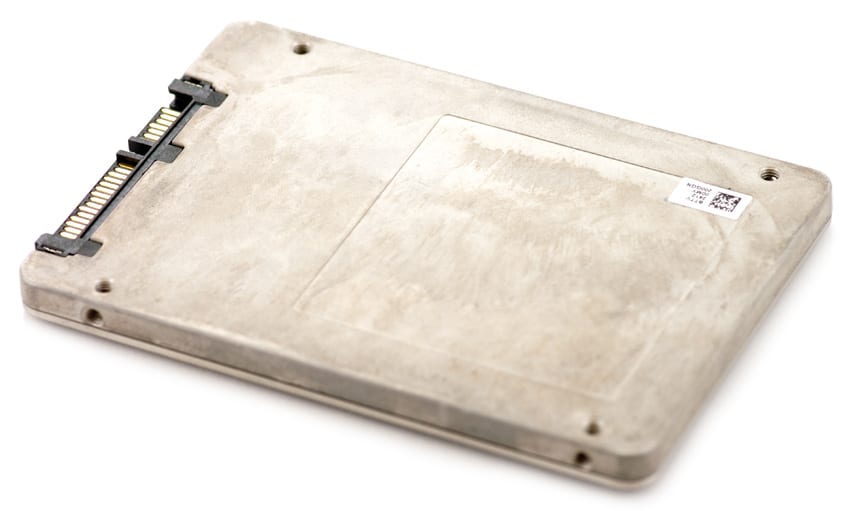
The body of the SSD DC S3700 is metal alloy, with a matte texture thanks to the unfinished metal. Intel has always taken the approach of having very minimalistic designs with their storage products and the new S3700 is no exception. Taking off the top cover exposes the single circuit board inside. Intel still retains some plastic shims inside the case for added rigidity around the screw holes, but other than that this is a no-frills setup.

At the heart of the Intel SSD DC S3700 is the new PC29AS21CA0 SATA 6.0Gb/s controller which is unique to this drive for now. Besides the SAS-based Intel/Hitachi controller found in Hitachi SSD400M and SSD400S.B (as well as the PCIe Intel SSD 910) this is Intel’s first SATA 6.0Gb/s controller, following in the footsteps of the older SATA 3.0Gb/s PC29AS21BA0 found in the SSD 710 and SSD 320.
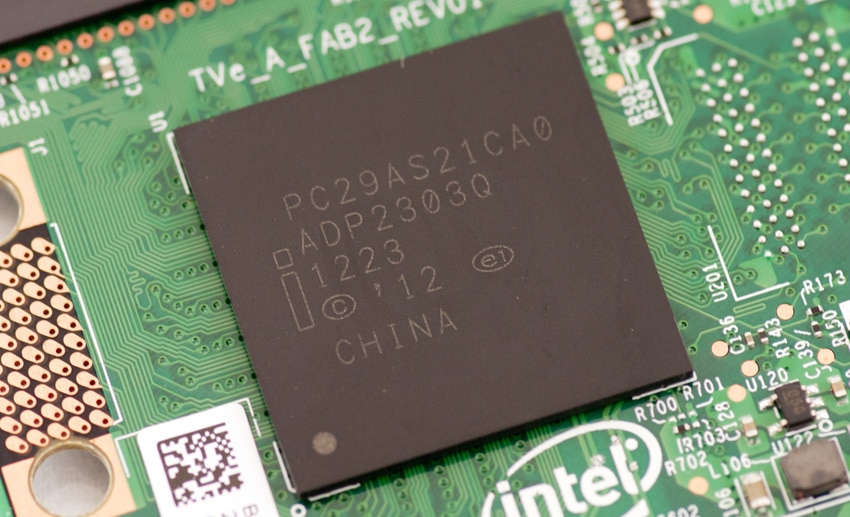
Intel uses their own NAND inside the SSD DC S3700, which in the case of the 200GB capacity includes 264GB of NAND split amongst sixteen NAND pieces of varying capacity. This isn’t the first SSD with an odd NAND count, as the Hitachi SSD400M and SSD400S.B also used different NAND sizes to populate all the controller’s channels.
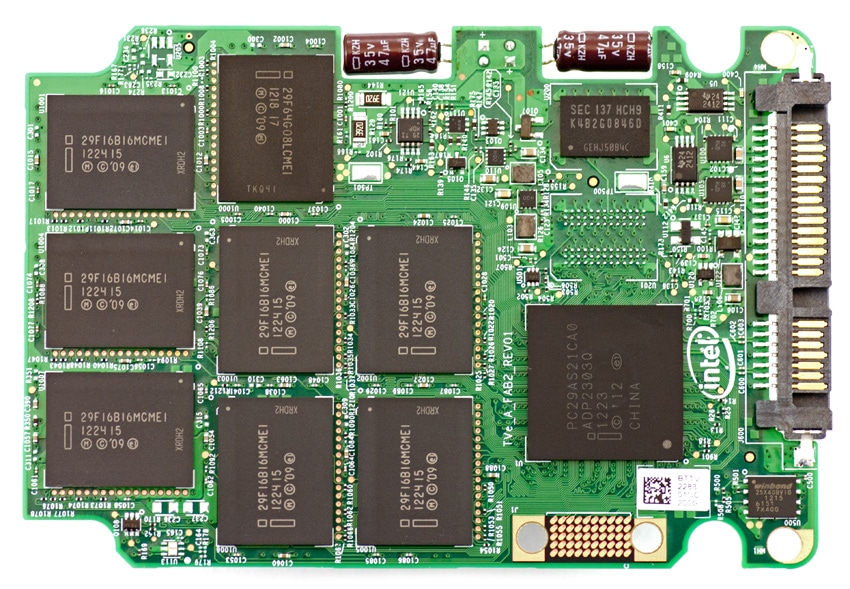
A view from the bottom of the circuit board shows the remaining eight pieces of NAND, as well as the capacitors soldered into the cutouts in the PCB. These are used the flush in-flight data to NAND in the event of a power loss.
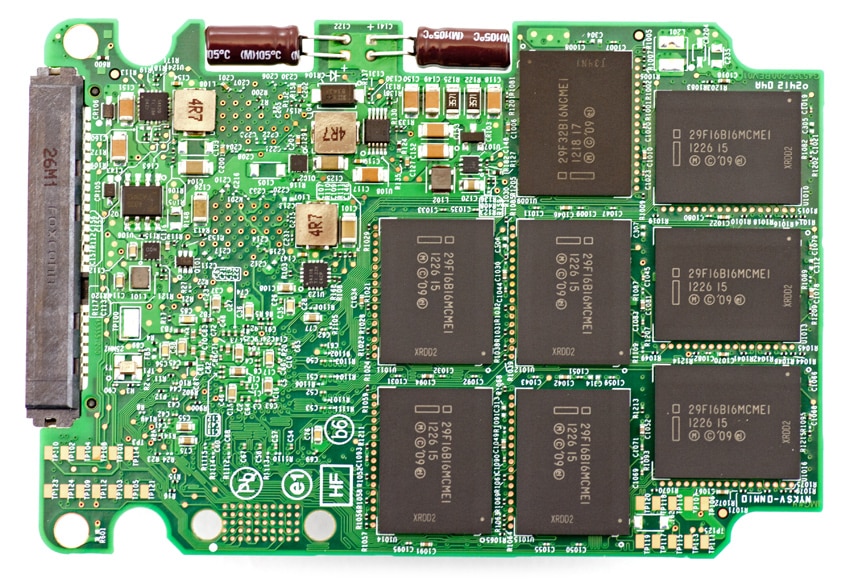
Testing Background and Comparables
The Intel SSD DC S3700 uses an Intel PC29AS21CA0 controller and Intel HET MLC NAND with a SATA 6.0Gb/s interface.
Comparables for this review:
- Intel SSD 710 (200GB, Intel PC29AS21BA0 controller, Intel 25nm eMLC NAND, 3.0Gb/s SATA)
- Samsung SM825 (200GB, Samsung S3C29MAX01-Y330 controller, Samsung 30nm eMLC NAND, 3.0Gb/s SATA)
- Hitachi SSD400M (400GB, Intel EW29AA31AA1 controller, Intel 25nm eMLC NAND, 6.0Gb/s SAS)
- PureSi Kage S1 (200GB, SandForce SF-2500 controller, Toshiba 24nm eMLC NAND, 6.0Gb/s SATA)
- Kingston SSDNow E100 (200GB, SandForce SF-2500 controller, Toshiba 24nm eMLC NAND, 6.0Gb/s SATA)
All enterprise SSDs are benchmarked on our enterprise testing platform based on a Lenovo ThinkServer RD240. The ThinkServer RD240 is configured with:
- 2 x Intel Xeon X5650 (2.66GHz, 12MB Cache)
- Windows Server 2008 Standard Edition R2 SP1 64-Bit and CentOS 6.2 64-Bit
- Intel 5500+ ICH10R Chipset
- Memory – 8GB (2 x 4GB) 1333Mhz DDR3 Registered RDIMMs
- LSI 9211 SAS/SATA 6.0Gb/s HBA
Enterprise Synthetic Workload Analysis
Flash performance varies throughout the preconditioning phase of each storage device. Our enterprise storage benchmark process begins with an analysis of the way the drive performs during a thorough preconditioning phase. Each of the comparable drives are secure erased using the vendor’s tools, preconditioned into steady-state with the same workload the device will be tested with under a heavy load of 16 threads with an outstanding queue of 16 per thread, and then tested in set intervals in multiple thread/queue depth profiles to show performance under light and heavy usage.
Preconditioning and Primary Steady-State Tests:
- Throughput (Read+Write IOPS Aggregate)
- Average Latency (Read+Write Latency Averaged Together)
- Max Latency (Peak Read or Write Latency)
- Latency Standard Deviation (Read+Write Standard Deviation Averaged Together)
Our Enterprise Synthetic Workload Analysis includes four profiles based on real-world tasks. These profiles have been developed to make it easier to compare to our past benchmarks as well as widely-published values such as max 4K read and write speed and 8K 70/30, which is commonly used for enterprise drives. We also included two legacy mixed workloads, the traditional File Server and Webserver, each offering a wide mix of transfer sizes.
- 4K
- 100% Read or 100% Write
- 100% 4K
- 8K 70/30
- 70% Read, 30% Write
- 100% 8K
- File Server
- 80% Read, 20% Write
- 10% 512b, 5% 1k, 5% 2k, 60% 4k, 2% 8k, 4% 16k, 4% 32k, 10% 64k
- Webserver
- 100% Read
- 22% 512b, 15% 1k, 8% 2k, 23% 4k, 15% 8k, 2% 16k, 6% 32k, 7% 64k, 1% 128k, 1% 512k
In our first workload with consisting of 100% 4K random write activity in full saturation, we measured a bit over 50,000 IOPS burst from the Intel SSD DC S3700 before taping off to around 34,000 IOPS. This performance was well over any other SSD in this category, including the SAS-equipped Hitachi SSD400M.
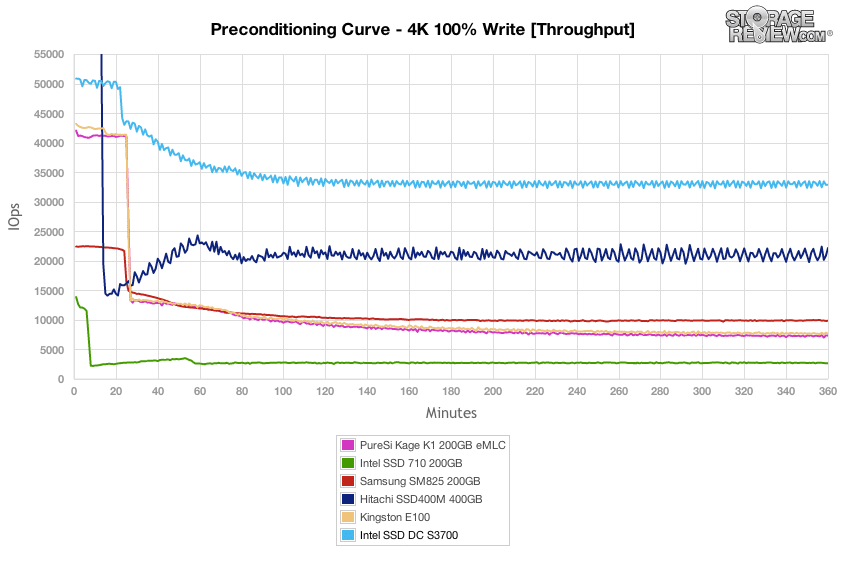
As the Intel SSD DC S3700 neared steady-state with a 16T/16Q load, it averaged a response time of about 8ms, well below what the SSD 710 was capable of pushing 90ms+.
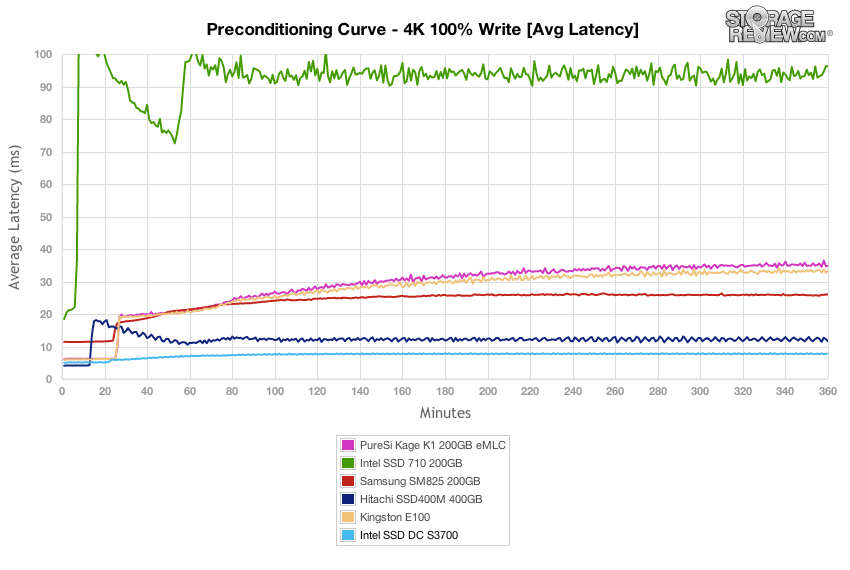
One of the most important attributes of any enterprise SSD is how it behaves in terms of max latency during a constant enterprise workload. While Intel claims fairly impressive sub-0.05ms peak response times with a 1T/1Q 4K random read or write load, that isn’t entirely representative of real-world enterprise conditions. With a heavier load of 16T/16Q, well past the point of full saturation, we measured peak response times of 400-500ms throughout our preconditioning process. In this same workload the SATA-based Samsung SM825 and SAS-based Hitachi SSD400M both were able to offer lower max response times.
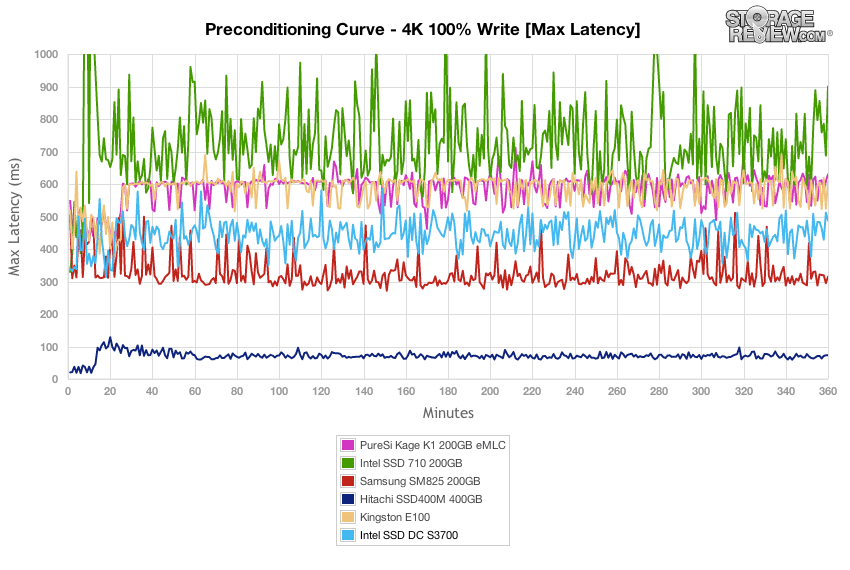
Diving into latency standard deviation, which shows how consistent the response times from each SSD measured, we found the Intel SSD DC S3700 to be the most consistent MLC SATA SSD, but the eMLC SAS-based Hitachi SSD400M did offer an edge.
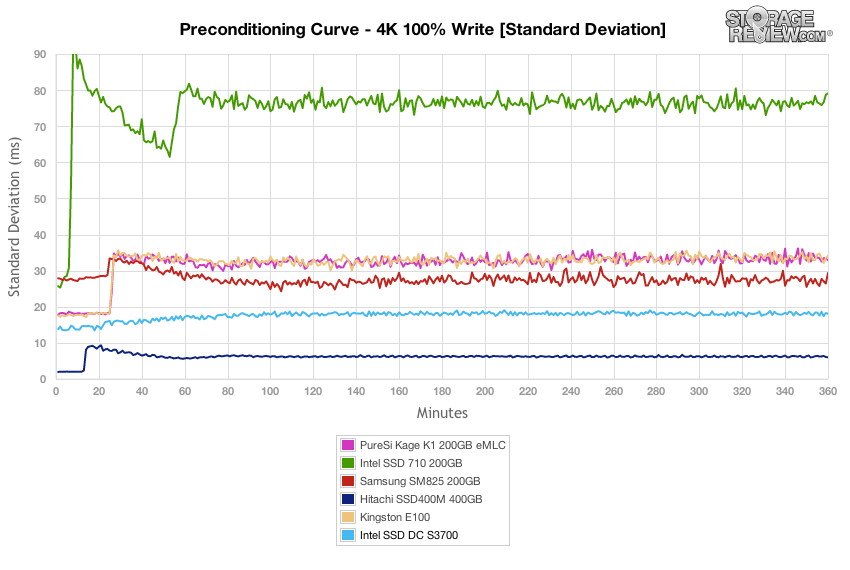
After we finished our preconditioning process we dropped straight into a 100% write and 100% read 4K random workload to measure each drive well after they reached steady-state. With a 16T/16Q workload, we measured 33,830 IOPS read and 33,016 IOPS write from the Intel SSD DC S3700. It offered the highest 4K write performance, although the SSD400M offered higher 4K random read performance in these conditions.
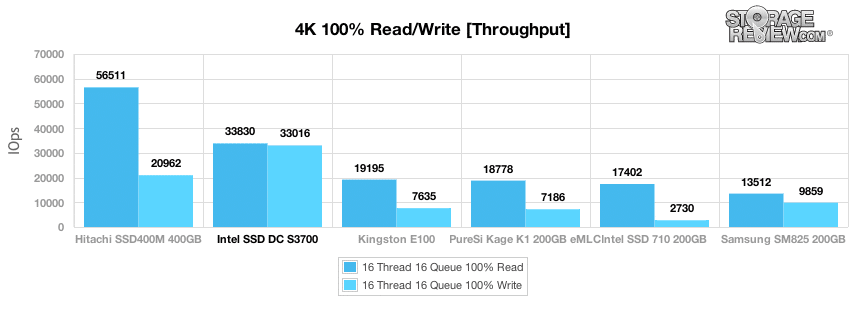
Average latency measured 7.57ms read and 7.75ms write in our main 4K random transfer test, with the Intel leading on write average response times.
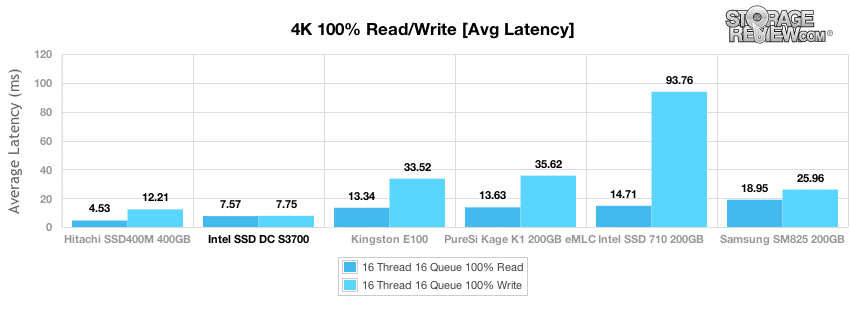
During our longer sample period as we measured our primary 4K results, we measured a peak read response time of 370.9ms and a peak write response time of 513.7ms. This put the DC S3700 roughly middle of the pack in both read and write peak latency.
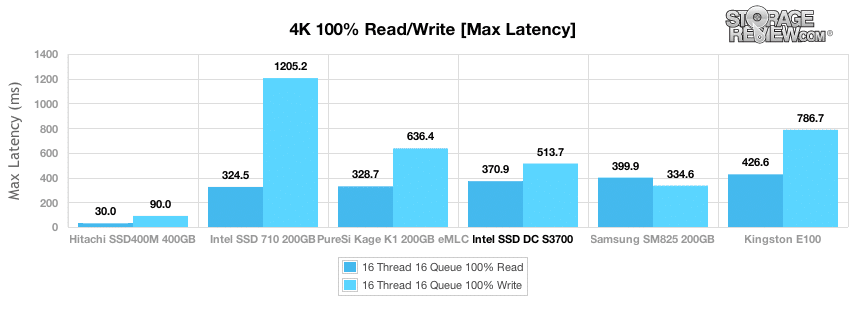
While peak latency shows a one time maximum, standard deviation shows how the drive performed over the entire course of our test. In terms of most consistent output, the Intel SSD DC S3700 came in second in our group, right behind the Hitachi SSD400M.
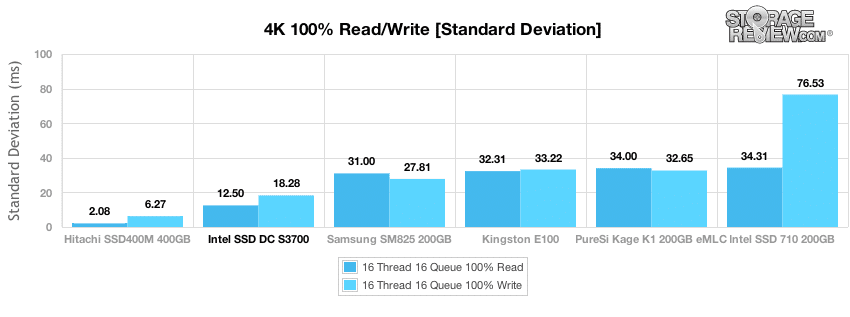
In our first mixed workload using an 8K profile 70/30% read/write spread and a constant 16T/16Q load, we measured a peak rate of around 44,000 IOPS from the Intel SSD DC S3700 before tapering off to roughly 16,000 IOPS. This compared to a steady-state speed of just 3,000 IOPS from the previous-generation Intel SSD 710.
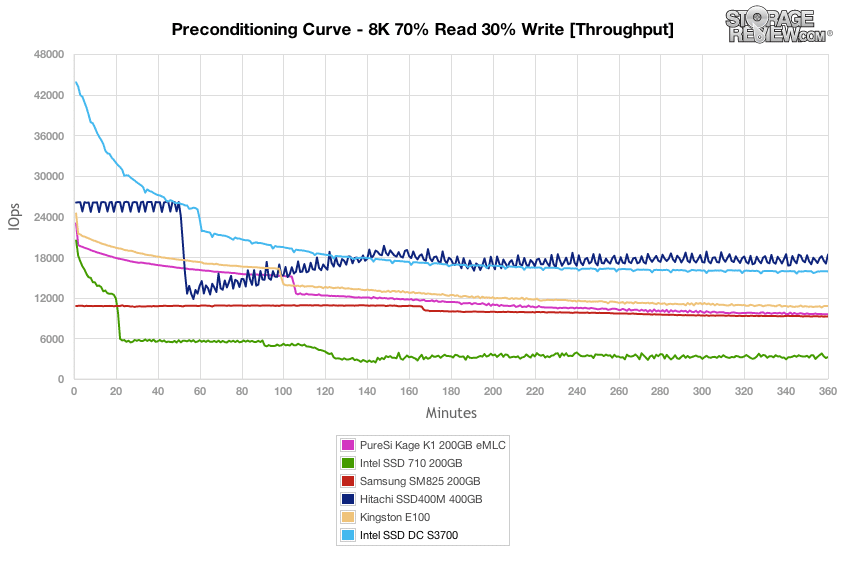
Measuring average latency in our 8K 70/30 preconditioning curve, we recorded a speed of about 16ms from the DC S3700 as it neared steady-state, versus 70-80ms from the SSD 710.
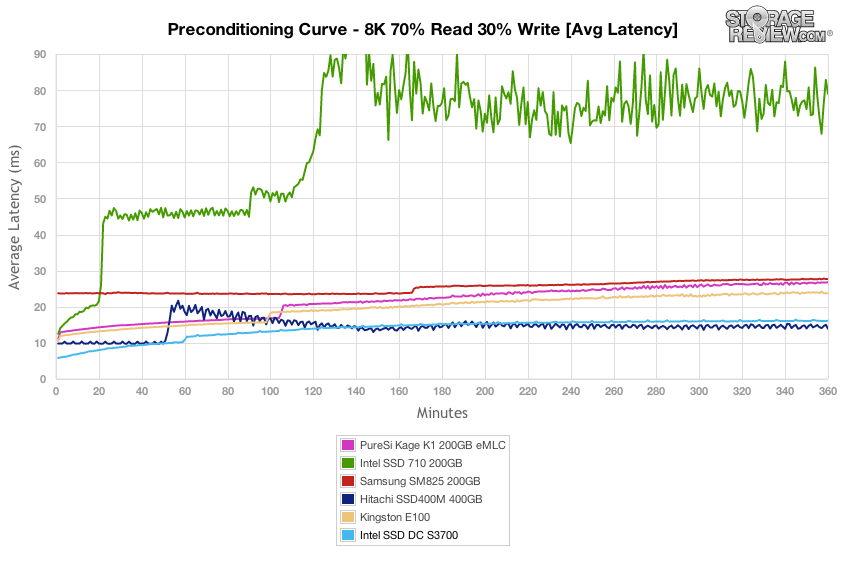
When it came time to keeping the peak response times low, the Intel SSD DC S3700 came in middle of the pack in our 8K 70/30 preconditioning workload, with times varying between 300-500ms. While this was a huge improvement from the SSD 710 which measured as high as 2,000ms, the Hitachi SSD400M kept its peaks under 100ms over the duration of the test.
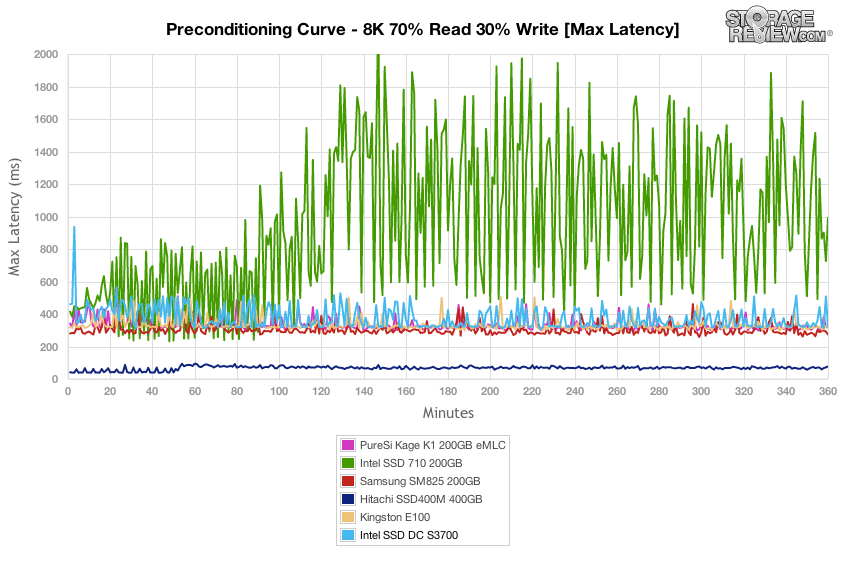
Comparing the latency standard deviation in our 8K 70/30 preconditioning curve, the Intel SSD DC S3700 came in at the bottom of the pack of current enterprise SATA SSDs, although still well above the SSD 710 that it replaced. The leader in this workload by far is the Hitachi SSD400M and to a lesser extent the Samsung SM825 which offered better composure in this workload.
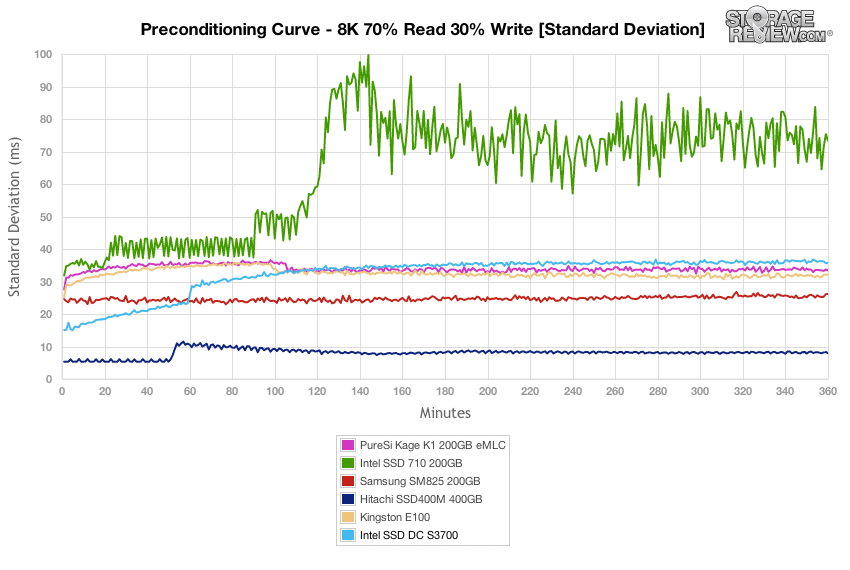
Compared to the fixed 16 thread, 16 queue max workload we performed in the 100% 4K write test, our mixed workload profiles scale the performance across a wide range of thread/queue combinations. In these tests we span workload intensity from 2 threads and 2 queue up to 16 threads and 16 queue. In the expanded 8K 70/30 test, the Intel SSD DC S3700 offered a clear advantage over the rest of our comparables, peaking at a substantially higher rate than anything else in this category. At the higher workloads though over a QD32, the interface became the bottleneck, where the SAS-based Hitachi SSD400M was able to offer more consistent, albeit lower, performance up to the highest thread and queue counts.
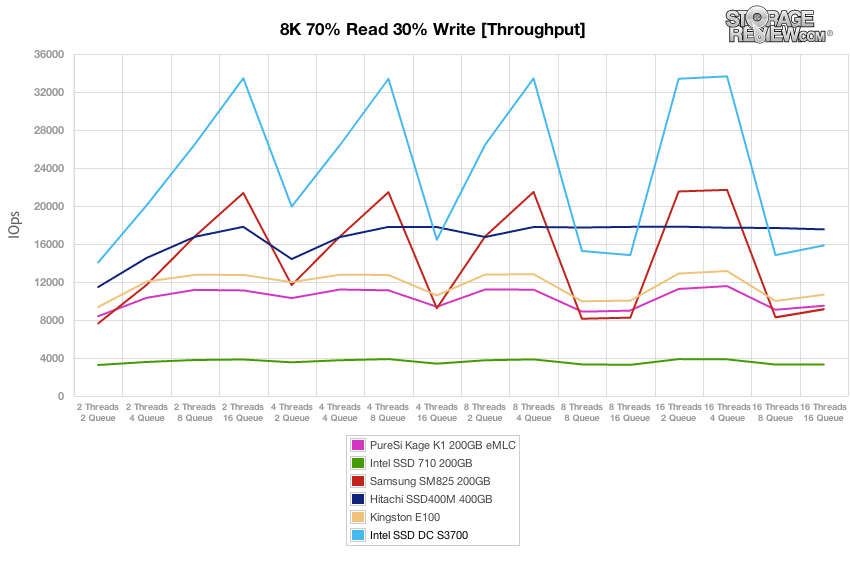
Comparing average latency in our varying load 8K 70/30 test, you can quickly see how much of an improvement the new DC S3700 offered over the SSD 710. While most products offer a linear improvement over previous-generation models, the S3700 offered a massive exponential jump in performance, perhaps showing the age of that original SATA 3.0Gb/s controller.
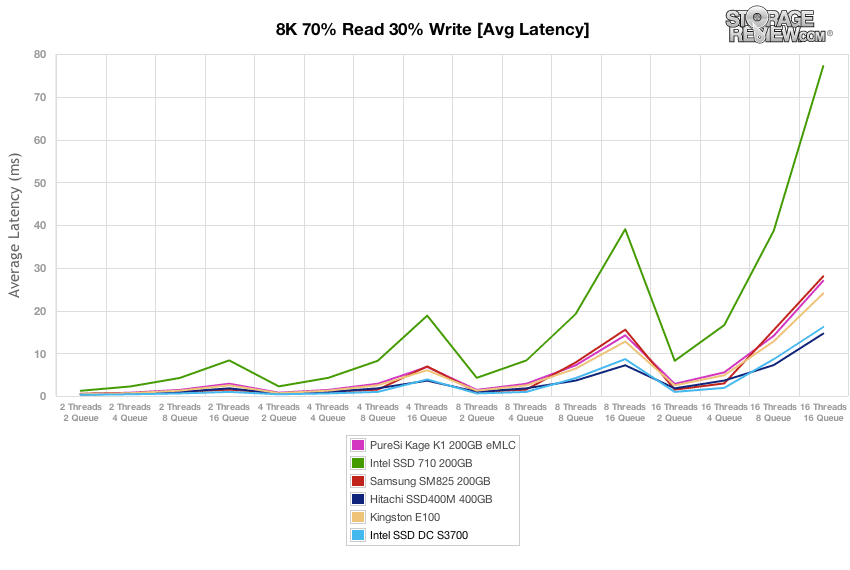
Looking at max response times, even QD levels below 32, the SAS-based Hitachi SSD400M still offered an edge over the new SATA-based Intel DC S3700. Compared to other enterprise SATA SSDs though, the Intel SSD DC S3700 did rank at the top of the pack.
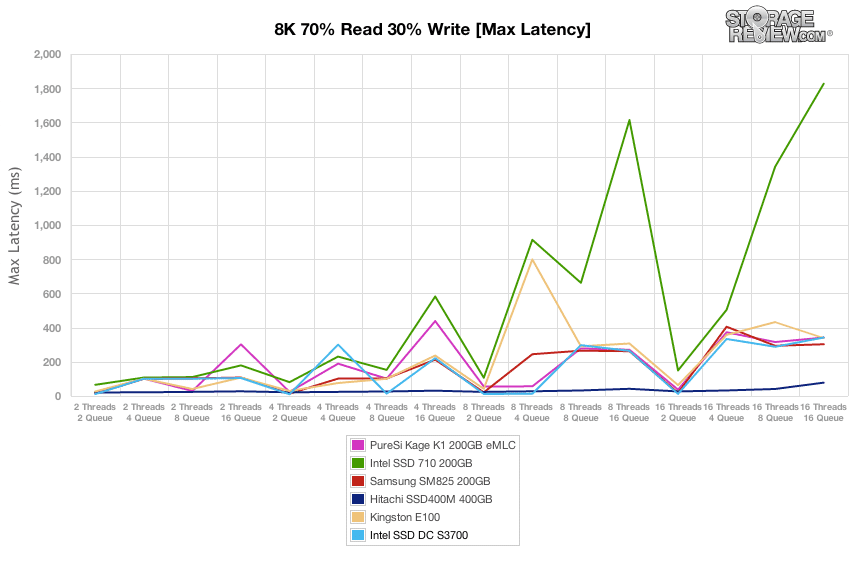
Comparing latency standard deviation, the Intel SSD DC S3700 was able to much better cope with loads over a QD32 than other SATA comparables, although it still wasn’t able to compete with the SSD400M which offered much tighter latency grouping in this workload.
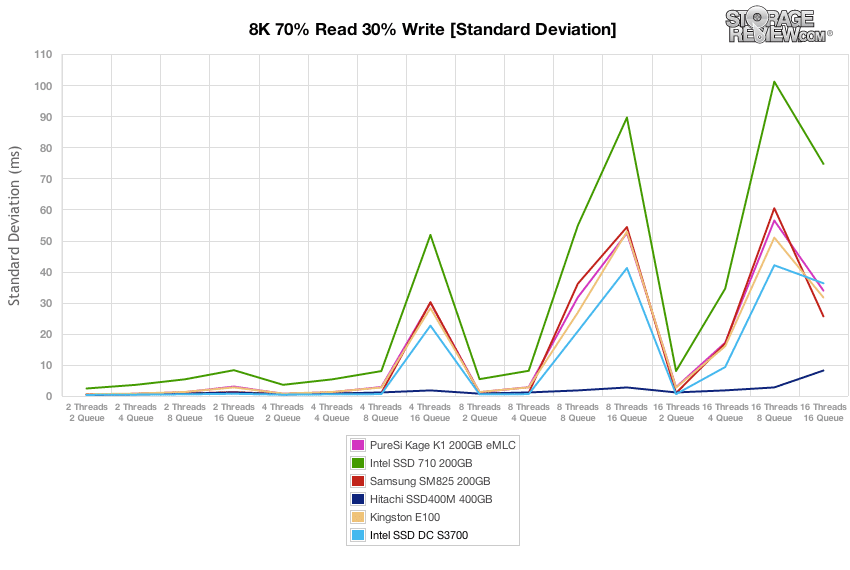
The next workload is our File Server profile, which covers a wide range of transfer sizes spanning from 512b to 512K. With a heavy 16T/16Q saturation load, the Intel SSD DC S3700 started with a burst speed of under 20,000 IOPS and tapered off with a steady-state speed of around 11,000 IOPS. It offered higher speed than the other SATA drives in this group and stayed right behind the SAS-based Hitachi SSD400M.
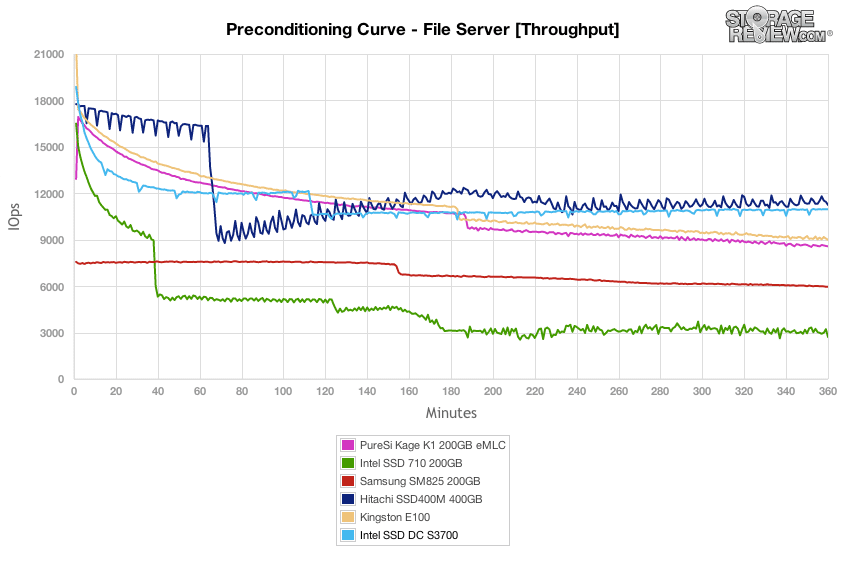
Switching to a view of average latency we can see the dramatic improvement the S3700 brings over the previous SSD 710. Average latency with a effective queue depth of 256 previous measured between 80-90ms, while it now levels off below 25ms.
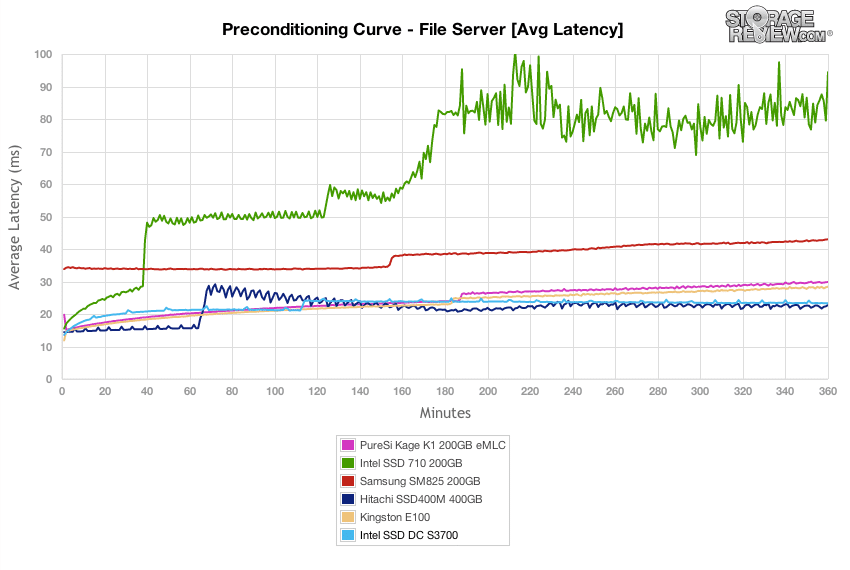
Comparing the peak response times of each SATA and SAS enterprise drive we found the max latency of the Intel SSD DC S3700 to measure in the same range as the eMLC-based SandForce SATA SSDs in the 300ms range. The previous SS 710 measured as high as 2,000ms, while the Samsung SM825 and Hitachi SSD400M came in at 200ms and 100ms over the course of our test.
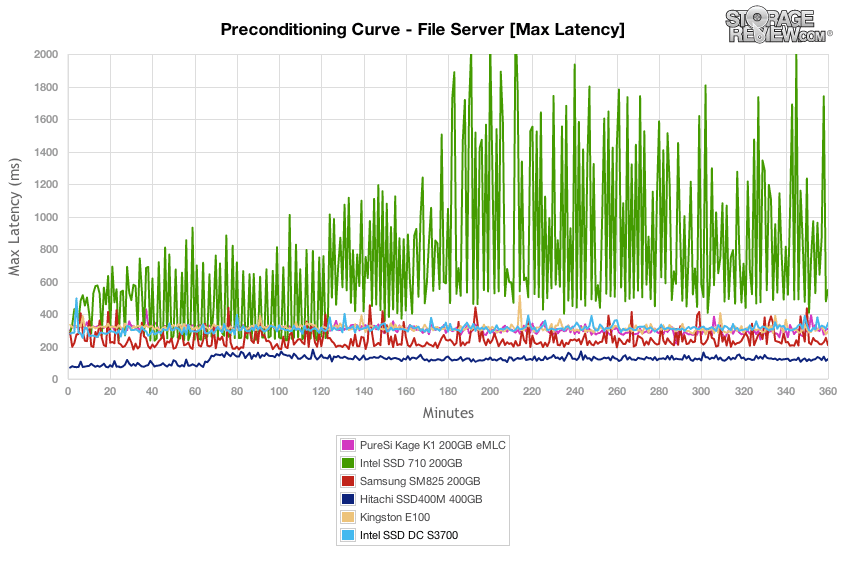
Switching our view to latency standard deviation to measure how consistent each drive kept its response times, we found the output of the S3700 to be very similar to the competing SandForce-powered enterprise models, which were slightly more consistent than the Samsung SM825 in this particular workload. The Hitachi SSD400M lead the pack though with a clear advantage at the higher saturation workload.
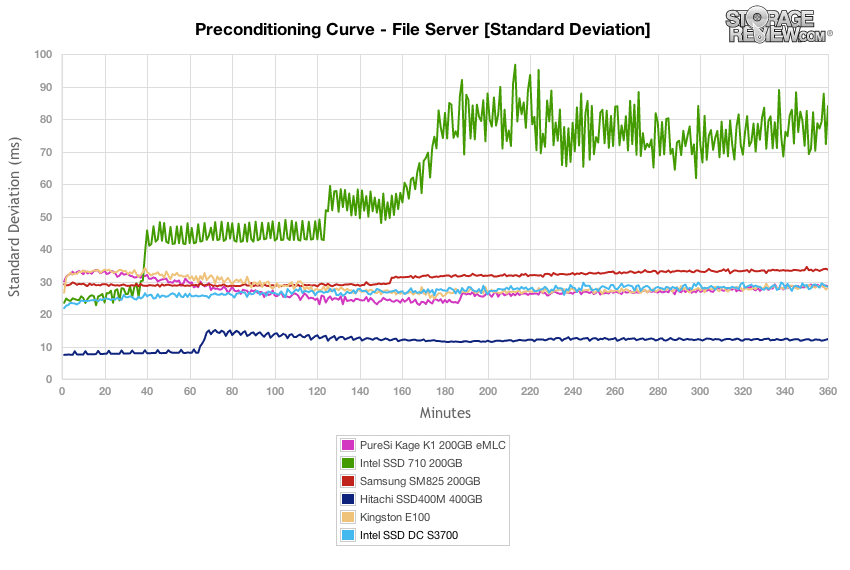
After each drive completed the preconditioning stage, we dropped into a varying workload where we scaled the thread and queue count from 2T/2Q up to 16T/16Q. The Intel SSD DC S3700 offered a substantial lead in I/O performance, offering double the speed of the SandForce SSDs.
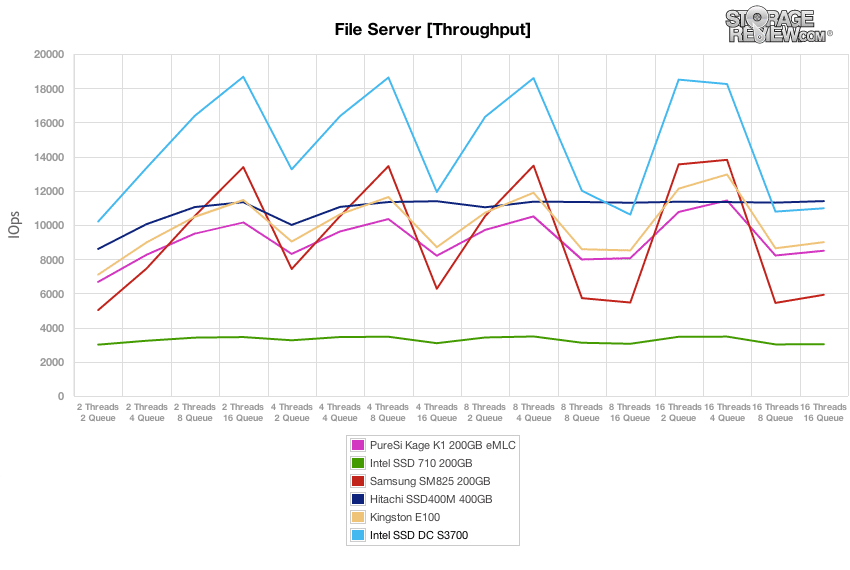
Average latency measured very well on the Intel SSD DC S3700, with response times staying below 10ms for the majority of loads up to 16T/8Q.
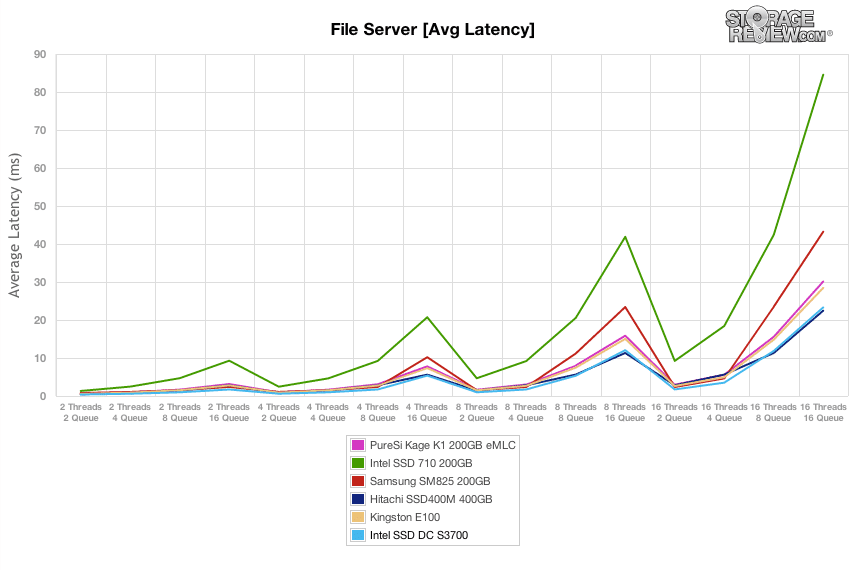
Switching to a view of max latency, the Intel SSD DC S3700 plotted in line with other eMLC SATA-based SSDs, although the SAS-based Hitachi SSD400M kept its peak response times sub-100ms for the bulk of the scaled thread/queue levels. The S3700 started to peak as high as 300ms, along with the other SATA enterprise SSDs as the thread and queue count increased.
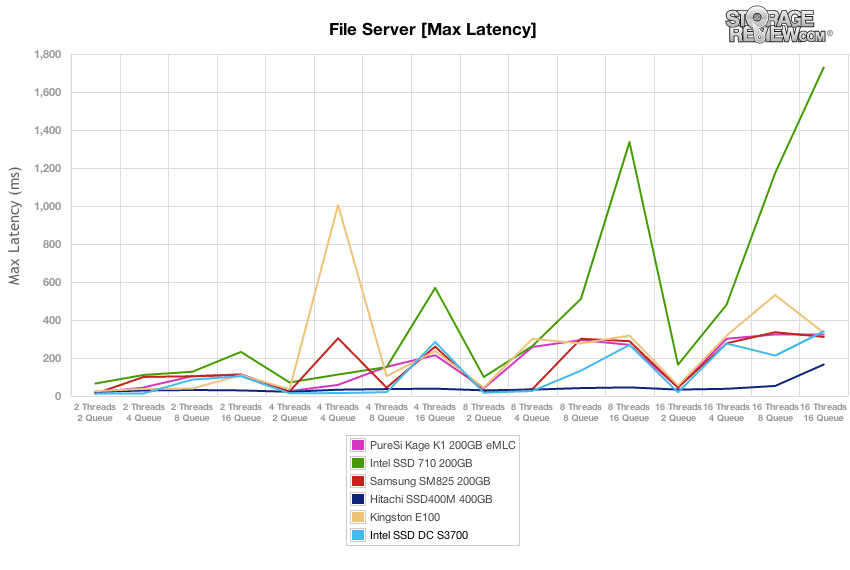
Comparing latency standard deviation in our File Server workload, we can see the dramatic difference in latency consistency as the SATA drives surpass an effective queue depth of 32. While the S3700 offered an edge over other SATA-based enterprise drives, it couldn’t comes close to the SAS-based SSD400M at queue depths over 32.
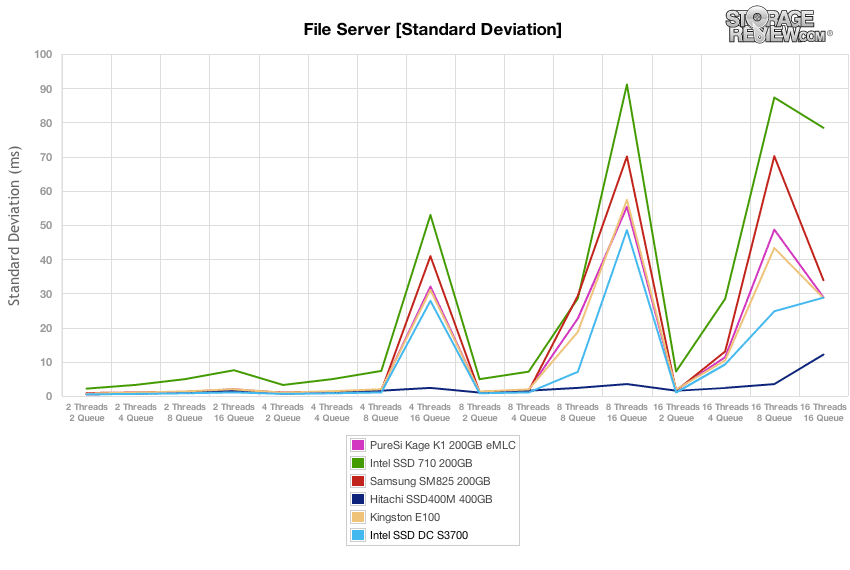
Our final preconditioning workload takes the traditional 100% read activity Web Server test and flips it to 100% write to precondition each SSD. This is our most aggressive workload, although it doesn’t really match any real-world conditions with 100% write. In this section the Intel SSD DC3700 measured much higher than the comparables.
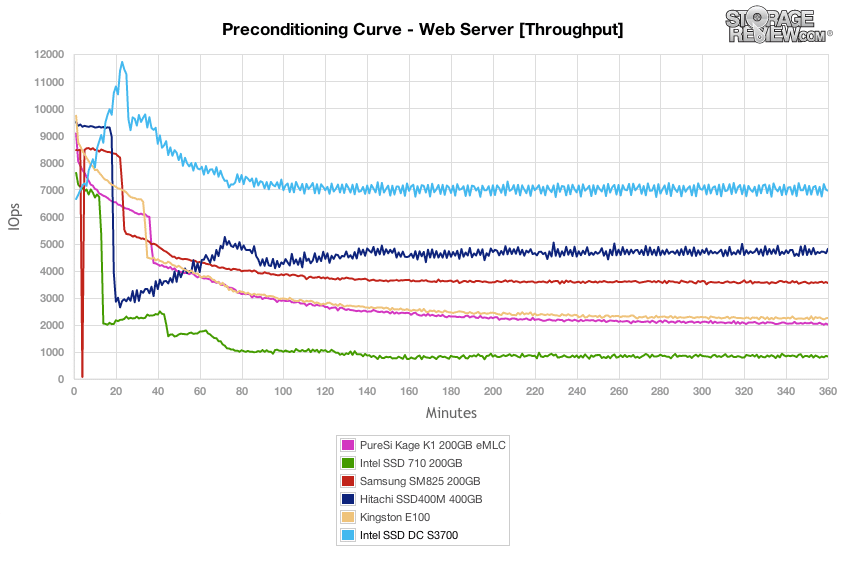
Average latency in this tough preconditioning load with an effective queue depth of 256 measured about 40ms from the S3700, versus up to 300-350ms from the prior SSD 710 model.
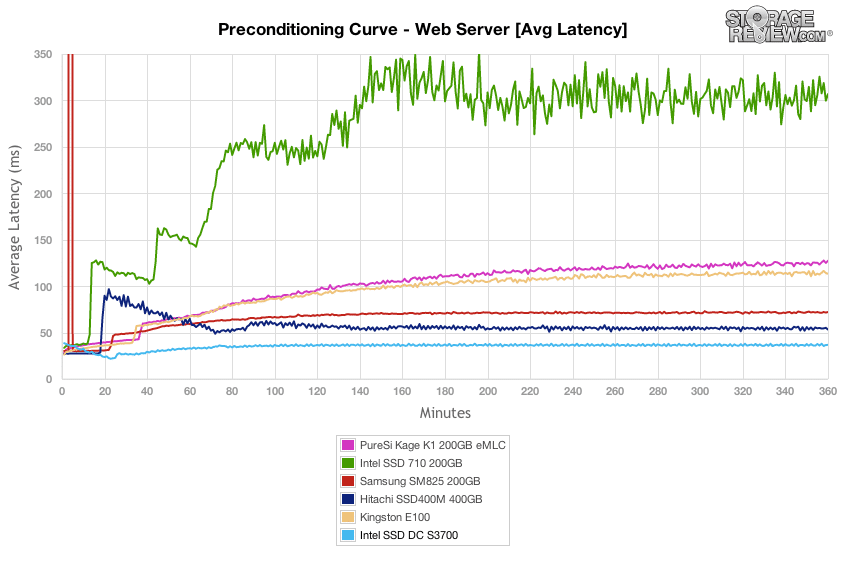
While the Intel SSD DC S3700 lost its edge against the SAS-based SSD400M in previous workloads during the preconditioning stage, it was on par in our Web Server test, measuring just below 250ms as it neared steady-state. This was a huge improvement over the previous generation Intel enterprise SSD, which ranged between 1,000-2,750ms.
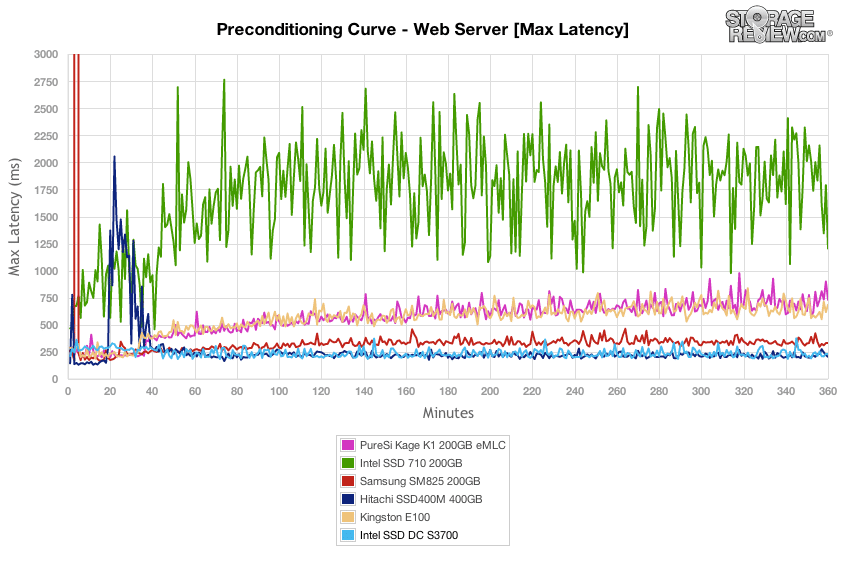
While the Hitachi SSD400M and Intel SSD DC S3700 measured roughly the same with peak response times, switching to standard deviation the SAS-based SSD400M offered the edge over the S3700. The S3700 still offered the best performance out of the SATA enterprise SSD group though, as well as a huge improvement over the SSD 710.
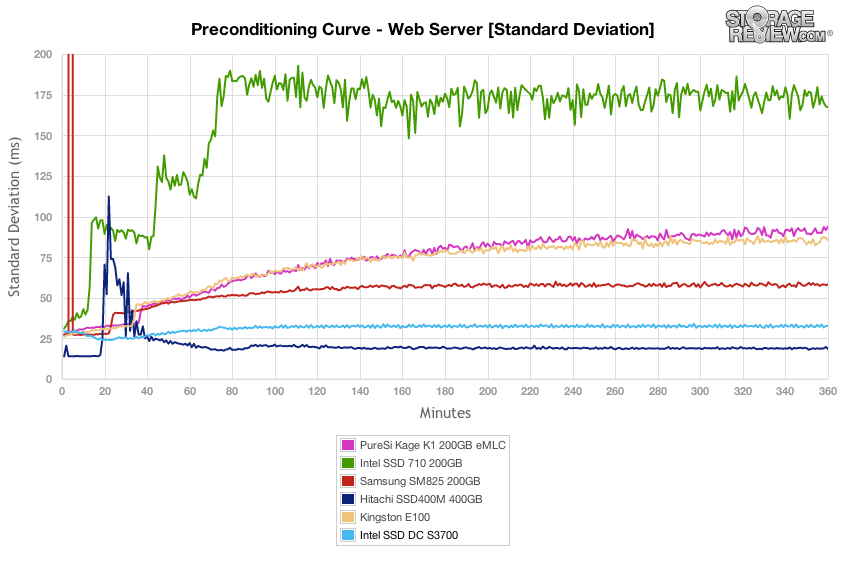
After each SSD finished our preconditioning stage in the Web Server test, we flipped the workload back to 100% read. In read-only conditions, the Intel DC S3700 offered the highest I/O performance at lower effective queue depths, but slipped below the SSD400M at levels higher than QD64.
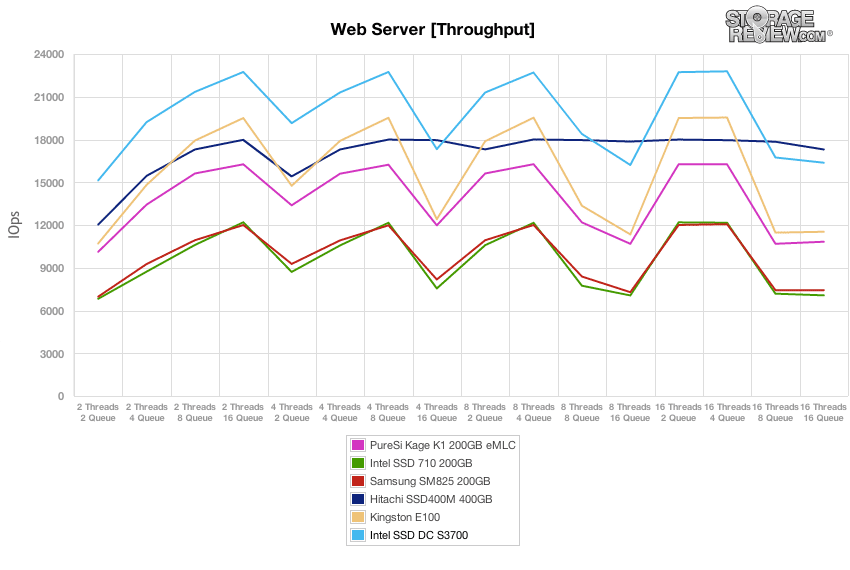
In our Web Server workload the Intel SSD DC S3700 was able to offer sub-5ms average latency at queue depths below 128, and stayed neck and neck with the eMLC SAS-based Hitachi SSD400m.
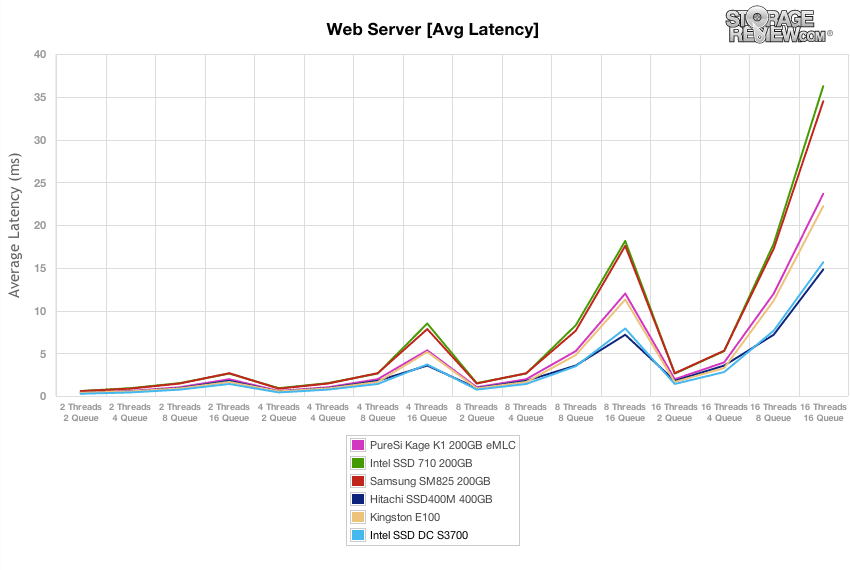
As we look at max read latency in our Web Server profile, we found the Intel SSD DC S3700 offered some of the lowest peak response times in the SATA SSD group, although it still spiked over 200ms at queue depth levels below 32. This contrasted with the SAS-based Hitachi SSD400m which offered sub-25ms over the duration of the test up to QD128.
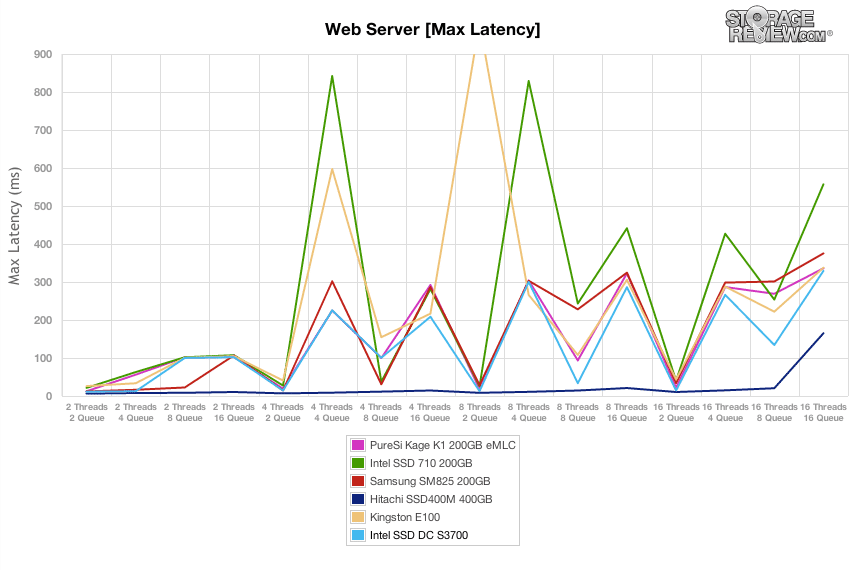
Drilling into the latency standard deviation in our Web Server workload, the Intel SSD DC S3700 kept its latency consistent up an effective queue depth of 32, but then spiked dramatically at levels above that.
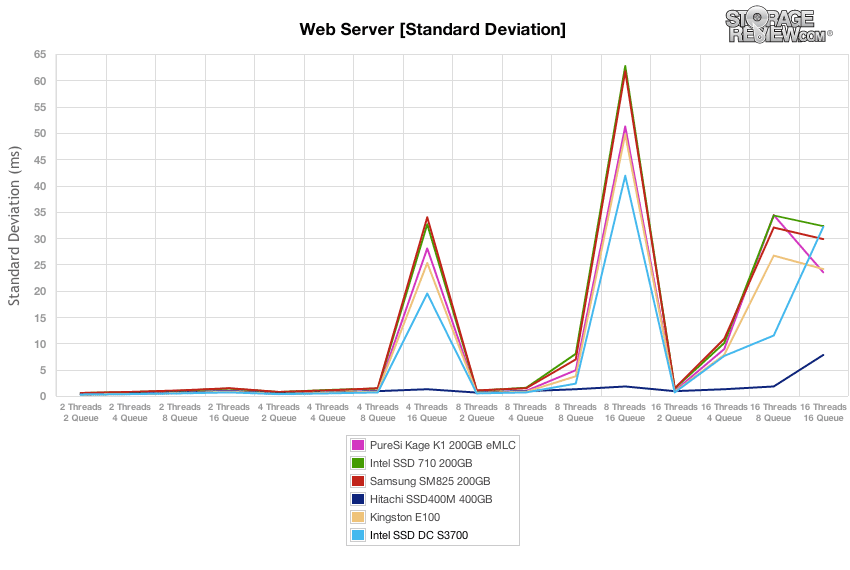
Intel DC S3700 vs SAS Competition
We usually compare like products in reviews, as it’s instructive to compare products in a market segment that compete head-to-head. The lines are sometimes blurred though, as they are in this case. Intel makes the case that the S3700 is the ideal drive for entry, mainstream and performance enterprise computing including HPC use cases. The claim is bold, largely because of the decision to go with a SATA interface, which has several limitations in the enterprise. The SATA interface tops out at a queue depth 32 (SAS scales as high as 256 in most cases) which means that when requests go above that level average and peak latency spike as we saw in all of our workloads.
Another huge advantage of SAS is the ability to offer dual-port modes for high availability scenarios, where there are two controllers interfacing with the same drive at the same time. In the event one goes offline, the connection with the SSD is not lost, as it would with a standard SATA interface without additional hardware. Some SAS drives also offer wide-port configurations used to increase total bandwidth above a single-link connection. While the Intel SSD DC S3700 against other SATA competitors is very fast, the story changes when you introduce the latest MLC and SLC-based SAS SSDs, which can cope better with increased thread and queue levels.
We picked the primary post-preconditioning sections of our benchmarks after each SSD had reached steady-state. For the purposes of this section, we added the Intel SSD DC S3700 onto the throughput charts of the newest SAS high-performance SSDs. There are also significant latency differences at higher queue depths that play a significant factor, but for the sake of easy comparison we stick with raw I/O speed across varying thread and queue counts.
In a 100% 4K random write or random read scenario, the Intel SSD DC 3700 performs quite well up against the high-end SAS competition, with the second fastest 4K steady-state speed. When you switch focus to read throughput at a heavy 16T/16Q load it only offers 1/2 to 1/3 the performance of SSDs in this category.
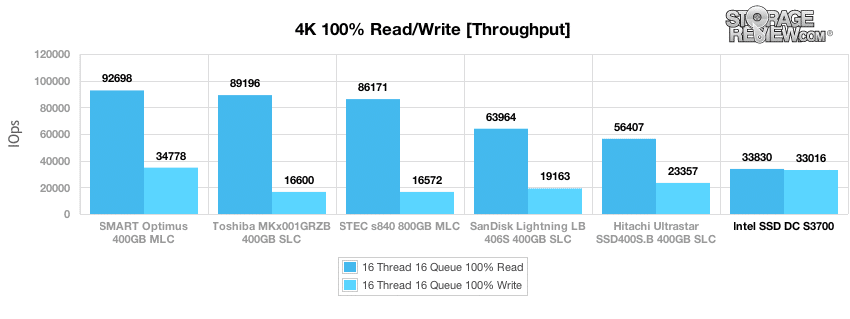
In our 8K 70/30 test where loads scale from 2T/2Q up to 16T/16Q, the Intel SSD DC S3700 shows its a capable performer at QD32 and below, although at levels QD64 and above, the DC S3700 falls off significantly compared to the SAS competition.
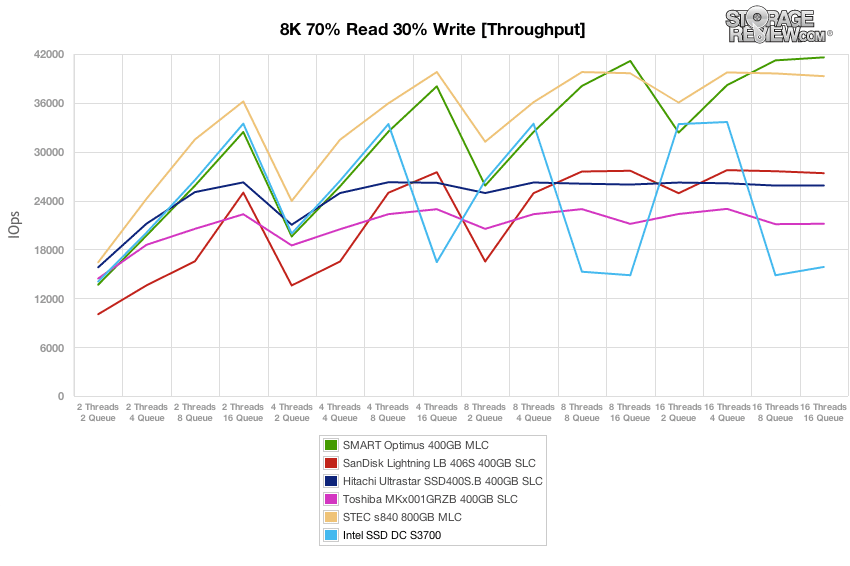
In our File Server workload, the advantage of the SSD DC S3700 stays competitive at effective queue depths below 16, but at higher levels high-performance SAS SSDs quickly surpass it.
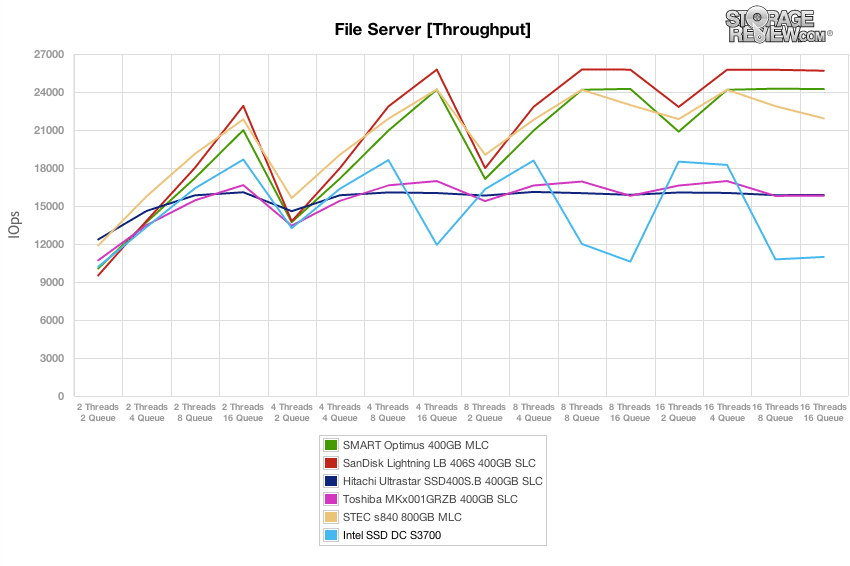
Turning to our Web Server workload, which is 100% read in this section of the test, the Intel SSD DC S3700 comes out of the gate with the highest performance at a 2T/2Q load, but quickly tops out at about 22,500 IOPS and then drops to 16,500 IOPS at higher QD levels.
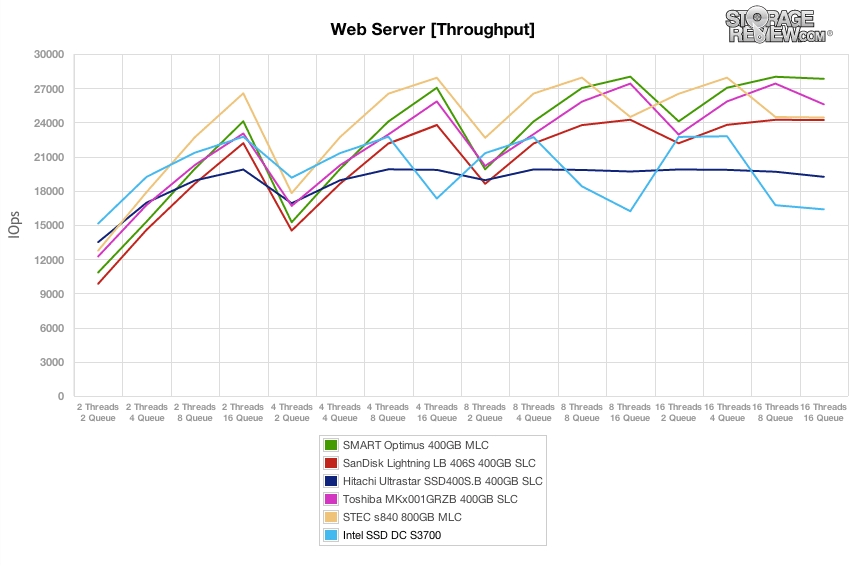
Conclusion
The Intel SSD DC S3700 Series represents everything Intel did extremely well when they led the market with their X25 series SSDs years ago. They dominated then with proprietary components and technologies that couldn’t be eclipsed by others for some time. The S3700 turns back the clock in this way; it’s simply a dominant product in terms of performance and endurance…in the SATA space at least. Much has changed in the enterprise storage space since Intel originally launched their first enterprise SSD though. Many players have entered the market with very competitive performance offerings, with prices continuing to drop as manufacturers develop IP to give MLC NAND SLC-like performance and endurance. In the face of such competition, Intel is bringing a lot of attention to their doorstep with their incredible consumer-like starting prices of the new DC S3700 and its very fast performance in the SATA space.
When it comes time to compare raw throughput, the Intel SSD DC S3700 wins hands down in the enterprise SATA space. Its new controller and NAND configuration allow it to push much higher speeds than any similar enterprise SSD, all at a price far undercutting the competition. In the enterprise market though it’s not just about throughput, with max latency and latency standard deviation playing a huge role in how well that SSD interacts with the applications and platforms designed around it. Peak response times and latency consistency is the one area that Intel falls back in compared to the large swath of SAS products.
The market in question then is the performance enterprise space which commands low latency and high data availability. Intel has aspirations for the drive to wage battle here but that’s unlikely as the interface simply limits the drive’s utility, where SAS drives dominate the market for their dual-port operating modes and ability to handle more intense workloads. This is one area that SATA has a hard time reaching up in to, since its performance has a hard limit far below where SAS tops out, and SATA misses the dual-port connection and end-to-end data protection SAS offers. These are features high-end enterprise environments demand; even a low entry price won’t sway their favor.
In the end Intel will certainly displace high-speed HDD media in some cases thanks to performance and cost, especially for boot and other entry enterprise workloads. For the performance workloads though, the DC S3700 simply can’t compete predictably with SAS SSDs that can handle more work in an intense, always-active type of environment. The S3700 will also pick up business in the flash array market, where most that use Intel are on the SSD 320. With the aggressive pricing of the S3700 and much improved performance, it wouldn’t be surprising to see the array guys migrate to the S3700 over the next year.
Pros
- Fastest SATA-based enterprise SSD
- Extremely competitive pricing
- Offered in density-maximizing 2.5″ 7mm and 1.8″ 5mm form-factors
Cons
- SATA interface greatly limits latency in high-load enterprise conditions
- Max latency claims unrealistic in enterprise workloads (1T/1Q 4K)
Bottom Line
The Intel SSD DC S3700 sets a new high-water mark for the entry and mainstream enterprise SSD space that use the SATA interface. Intel’s return to innovation with their own controller, NAND and high endurance technologies is welcome in a market that’s getting full of copycats. While the S3700 raises the bar for all SATA-based enterprise SSDs, compared to performance SAS SSDs, the S3700 can’t compete with their extremely low max latency and high IO throughput under heavy workloads.




 Amazon
Amazon